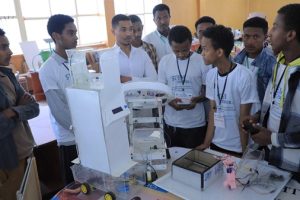
On the occasion of opening of an exhibition entitled ‘Ethiopia – Eritrea: Historical Albums’ various memorable old photos of Eritrea and Ethiopia were displayed. The photos themselves can comprehend a lot about the nations.
José-Marie Bel (PhD), French ethnologist, historian, visual artist and architect, has focused his studies on the heritage of the Horn of Africa and South Arabia since 1974. He carried out research, particularly, on the history and iconographic memory of the years 1880 to 1941.
The photos in the exhibition, above all, display various ethnic groups, splendid portraits of men, women and children as well as scenes of worship, ritual or simple everyday life of the two nations. These albums still contain mysteries: name of the photographer (s), exact dates and types of cameras used.
In an exclusive interview with The Ethiopian Herald, Bel said Ethiopia, as a whole, and Addis Ababa, in particular, has depicted a significant socio-political and economic change over a period of forty years.
He mentioned that the total population of Addis Ababa was about 6 hundred thousand when he first came to Ethiopia. The number of modern buildings in the city was few. Hilton was one of the hotels of the then time. Otherwise, there were no significant buildings except the small and beautiful village of huts. The city had been a quiet place with mild economic activity, as to the scholar.
The population of Addis Ababa has increase dramatically over a period of 40 years. The total population of the city at the moment is about 10 million. The new and modern buildings have been erected throughout the city. The business activities in the city have changed significantly over time. This makes the city one of the fastest growing, as to him.
As to Bel, Asmara, the capital of Eritrea, on the other hand, is a city that with a total population of about half a million. The city has not experienced a significant destruction from enemy. It has preserved her historical buildings.
Asmara is a quiet and clean city. The city was inaugurated in 1890s. It is a legendary capital which is as old as Addis Ababa. The city has not exhibited radical change over the last 70 years. Yet, the fine-looking beaches and historical buildings make her a remarkable city, he explained.
The scholar indicated ‘Legehar’ to be one of the historical heritage which needs to be conserved. It is the foundation of the Addis Ababa. It also is a place where the friendly relationship between Ethiopia and France was inaugurated. Piassa is also another historical part of the city, he added.
He also forwarded that the peoples of the two countries share culture, religion, dressing, and way of life. The two nations have common history. Thus, there is a need to establish a strong bond between them. Fortunately, the governments of the two countries have started working to establish a friendly relationship between the people. This is a good beginning, indicated the scholar.
The sistorian discovered the existence of amazing photographic albums produced by one or more Italian photographers in the years 1910- 1930: a monumental collection in black and white.
In the course of his study the historian has come across albums named ‘Fondazione dell’impero IX maggio Anno Xiv’ with reference to May 9, 1936, the date of Italy’s annexation of Ethiopia and Somalia.
The scholar uncovered that the monumental album is a tribute to what was Abyssinia at that time. It is a panorama depicting the beauties and characteristics of the then people. There were a few Italian style buildings, signs of the colonialism, whereas, many landscapes, natural sites, unknown villages, ancient cities and archaeological monuments where depicted by the album.
José-Marie Bel is ethnologist and historian of the Maison Rimbaud in Aden (Yemen, 1992-94). He has produced a large number of exhibitions, conferences and missions. He is the author of fifteen books. He is the co-founder the Queen of Sheba Space, former president of the Amis de Rimbaud and member of the Geographical Society, learnt from the exhibition.
The Ethiopian Herald February 15/2020
BY GETAHUN LEGESSE





